INTO THE ETHEREAL:
DESKTOP EXPERIENCE
Interactive Fiction and Haunted Operating System
2021
Exhibited at:
‘Goodbye Internet’ Festival with Oddstream, Nijmegen, 2021
‘Magic Mirrors’ with Extrapool, Nijmegen, 2021
DESKTOP EXPERIENCE
Interactive Fiction and Haunted Operating System
2021
Exhibited at:
‘Goodbye Internet’ Festival with Oddstream, Nijmegen, 2021
‘Magic Mirrors’ with Extrapool, Nijmegen, 2021
Into the Ethereal is an interactive fiction placed in a Post-Internet future, where servers of smaller social platforms such as Tumblr are shut down as a result of an oligopoly of larger platforms. Consequently, archives of certain marginalised online communities become wiped out and knowledge sharing takes on a different form.

Installation of Into the Ethereal: Desktop Experience

Opening Scene of Into the Ethereal: Desktop Experience
Into the Ethereal builds on the promises and limitations of digital technologies, and explores the lost futures of those left behind in abandoned or obliterated internet structures. It explores how memory can survive in the fragments of digital ruins, and how these forms of externalisation become products of our own identity. By using witchcraft as a methodology, this interactive piece explores new experiences that could emerge if human attitudes and views towards digital technologies become more spiritual, sensual and emotive.
In this space, the contemporary witch becomes a figure that gives legitimacy to enact new unconventional practice, whilst sharing and up-keeping situated knowledges that are marginalised by society. This narratively skilled voice brings the audience into an experience where previous ontological and epistemological constructs are disregarded. The witch allows the audience to acquire a new thinking tool, a perspective of the ‘Other’, a lens of an alien anthropologist, which has legitimacy to critique existing socio-political matters and create radical rituals with everyday technologies. Into the Ethereal intends to show how the lens of non-conformist cyberwitches can be applied into practice for creating new means of critique, de-naturalisation, empowerment and activism.
Into the Ethereal: Desktop Simulation

Into the Ethereal is a technological rite of passage and expedition of a visitor to a cyberwitch’s hut.
What does the journey through the experience look like?
What would the audience encounter along their way and what can they take away from the experience?
Taken through a cyber-labyrinth of doors and files, the audience navigates the environment of a desktop as an open world system. The language of architectural spaces, such as the kitchen, the bedroom, a hut and most importantly a variety of doors, allows the audience to imagine the game-play as a visit to an architectural site. The various rituals you encounter along the way, take place in specific times, contexts and environments. Into the Ethereal pushes our understanding of what the folder system could become as an archival space for connection, for discovering new forms of knowledge and for building analogue networks.
As one of the remaining workers in the building, you stumble upon an abandoned space, no longer utilised and locked away. Signs of abandonment instil a desire to rummage through the space, in search of clues that might provide insight into who came before you, what were their desires or motives, and you wonder whether any snippets can unveil some parts of their lives.
Along with a deactivated computer you find a neglected USB drive and a still functioning machine. What you come across is a derelict monument, repurposed and given a new meaning and role to act as a medium for opening a technological rite of passage into what appears to be an attempt to archive the practice of a contemporary nonconformist cyberwitch.
Welcome.
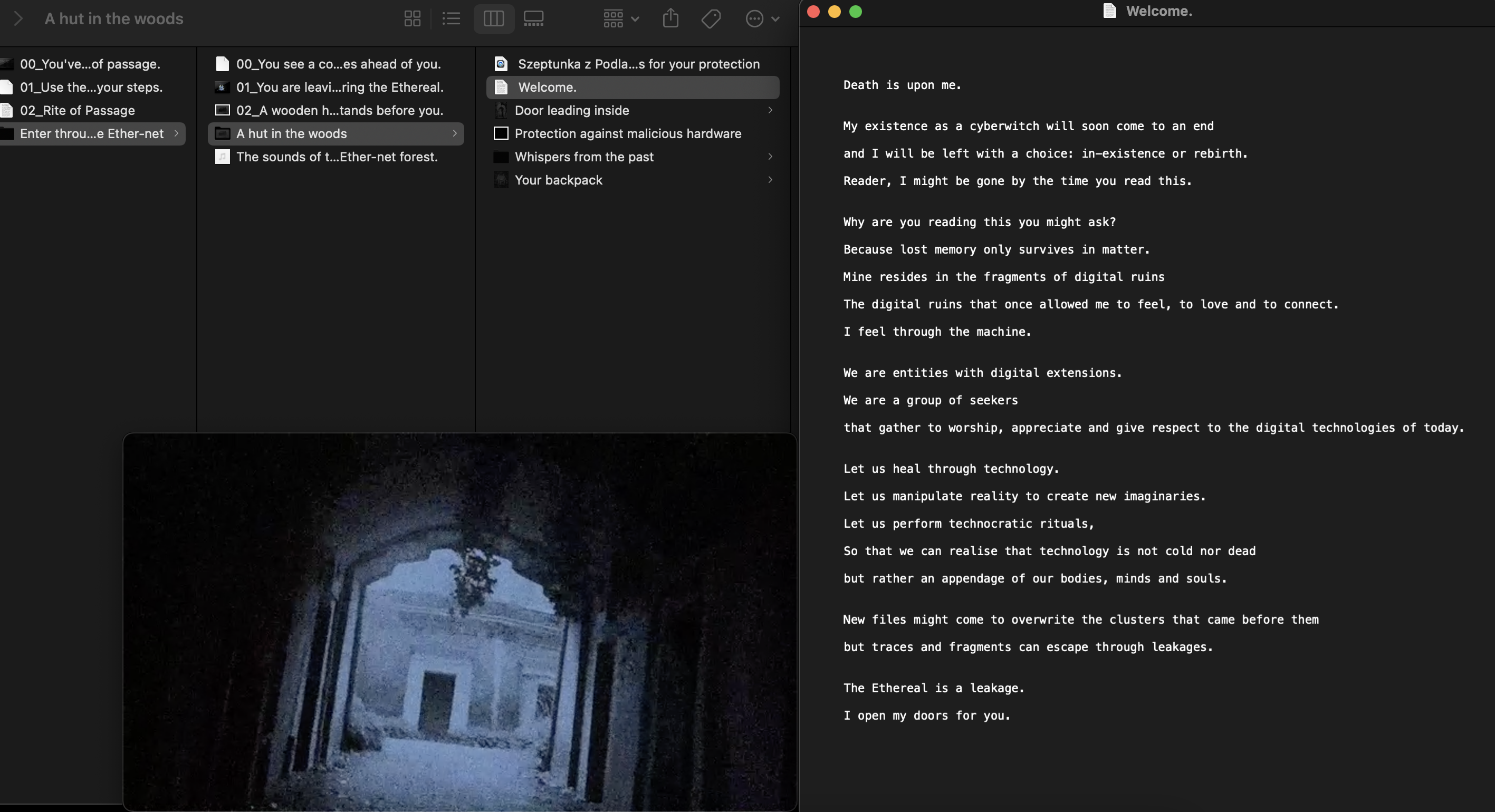
The introduction to the experience frames speculative digital witchcraft as a methodology to imagine new relationships, values and rituals of the future. Portrayed as a provocation, it imagines new and different kinds of research and politics in media and technology studies. The Welcome. message the participant firstly encounters acts as a manifesto that opens up a way of seeing that allows for the creation of radical alternative futures. The opening folder and its contents are also a personal confession and a prompt to ask the questions: what if the way we experience the world was not captured externally? What happens to memory without the network?
As Menking states: “In some instances, the bond between the user and the object, though, has strengthened to such an extent that people consider certain technologies to be extensions of their self-identities, even suffering physical withdrawals when some devices are lost or inaccessible” (2015, n.p).
The textual narrative brings the voice of the witch as a political figure that raises awareness of the risks of assumption that the social state will remain as it is right now, that nothing will change and that human values, habits and behaviours will largely remain the same. Rather than proposing a method of seeing the future and visualising what will happen, the witch prompts the audience to imagine ways of experiencing and feeling the future through ritual practice.
The Chamber: Purification Rituals

The witch describes the bed as a place “where we leave behind the actions and worries of today, to start anew tomorrow.” By portraying the bedroom as a place of rejuvenation, begs to question: what happens when we bring digital technology into this space?


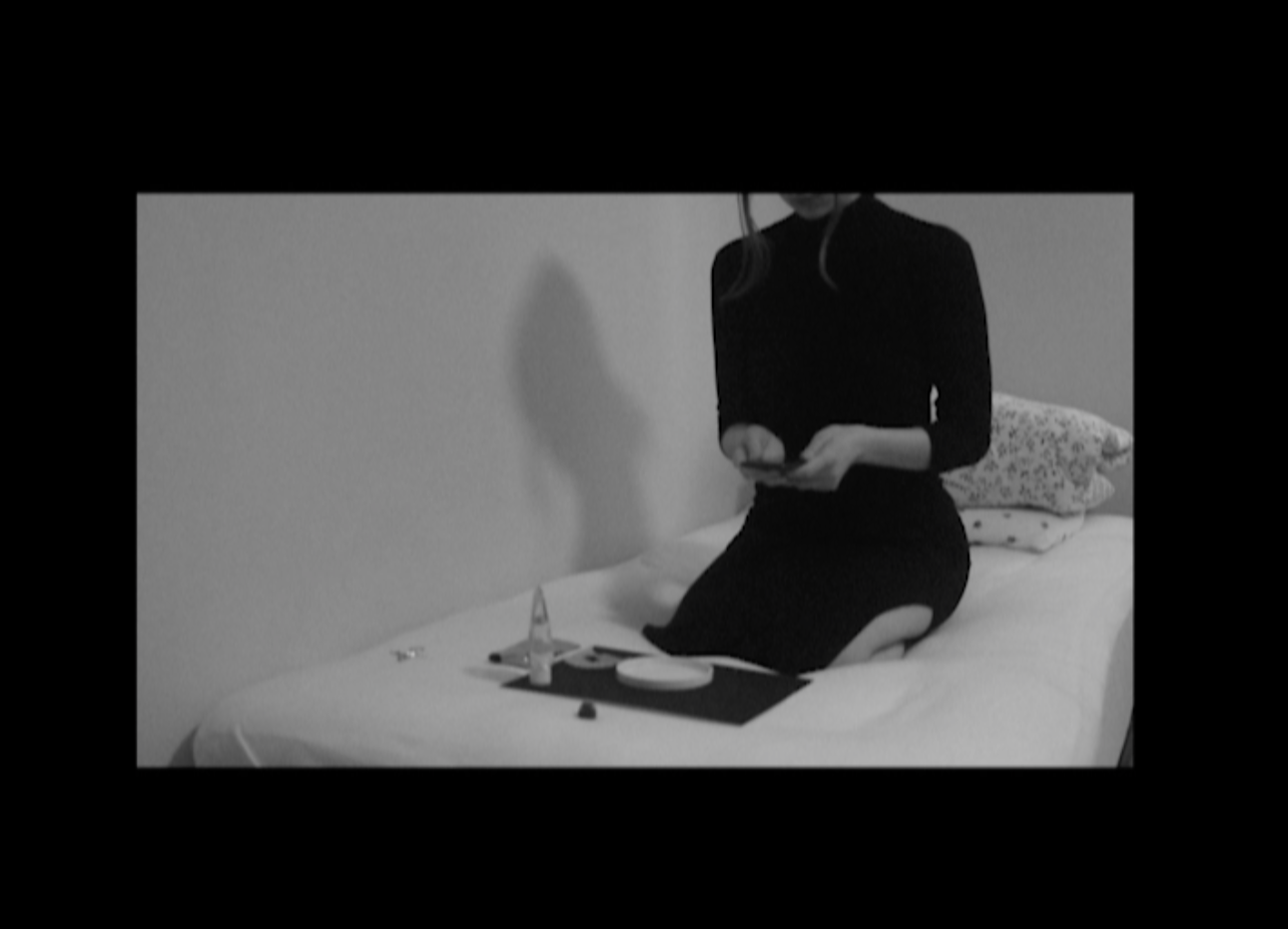
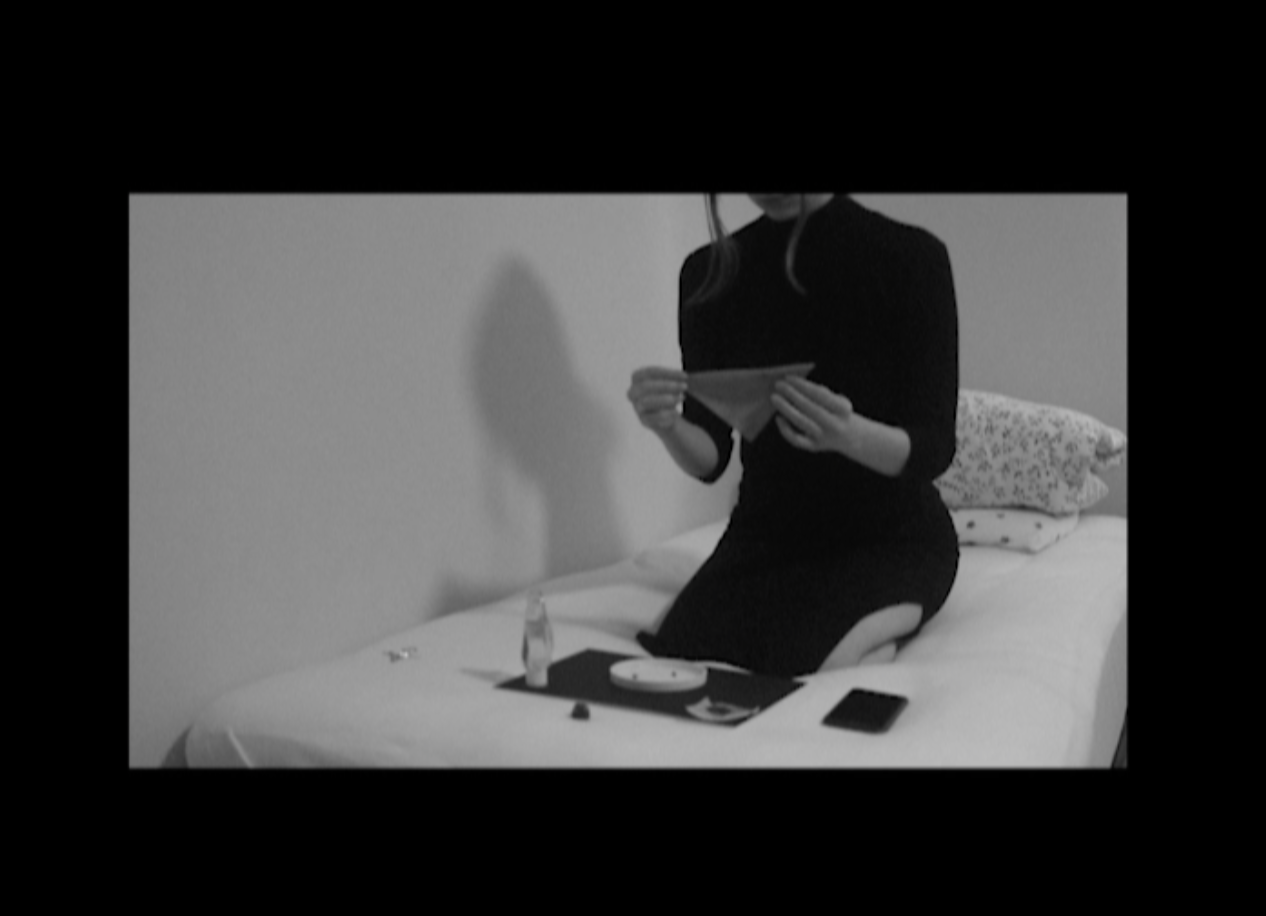

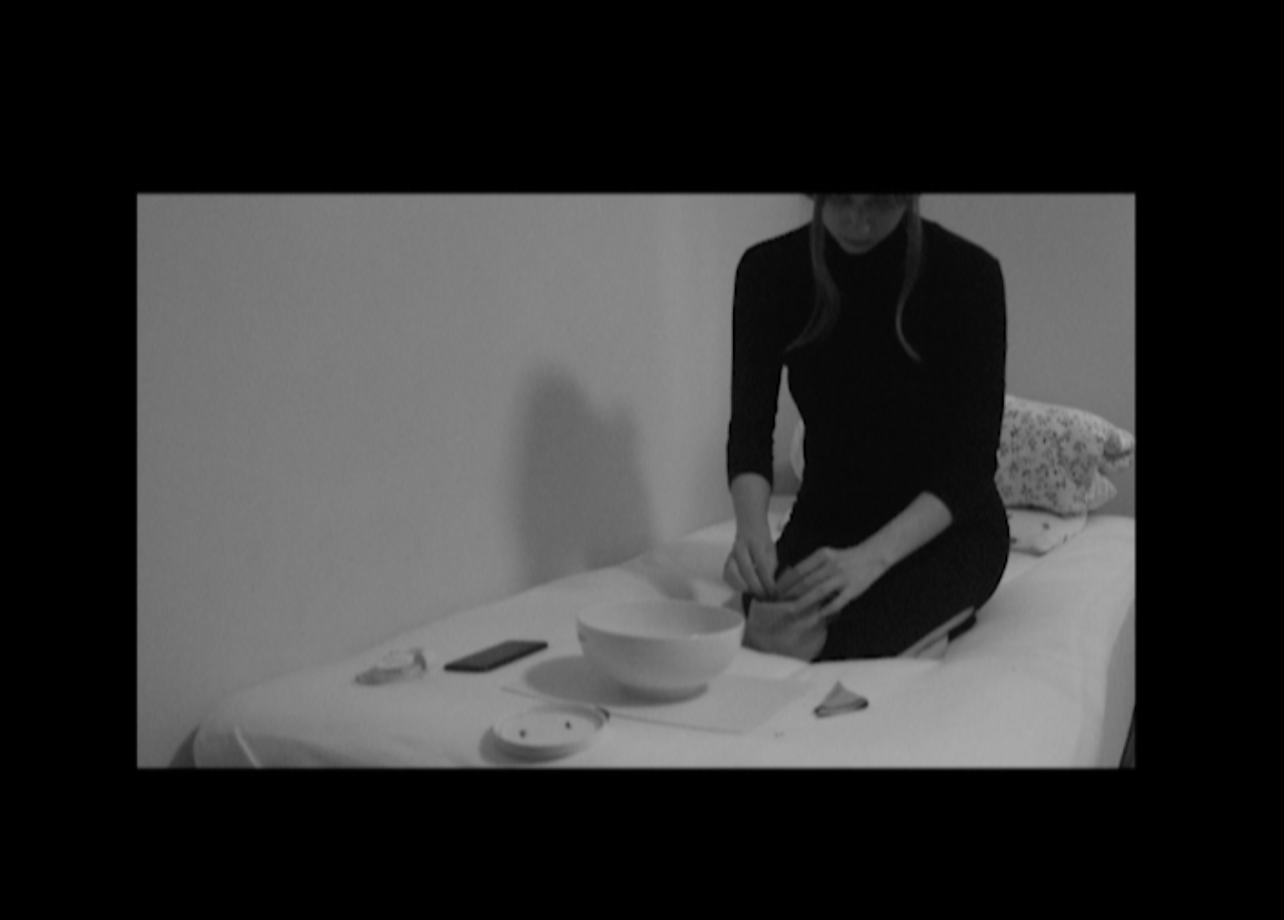
You encounter a choreographed sequence of gestures, forming a cleansing ritual that purifies technology from the imprints we leave behind. This designed moment of introspection and reflection asks the participant to recall “the actions that could have left the imprints, and the situations, emotions and places that those actions were tied to.” This ritual was designed with the intend to show how one can feel through technology and how digital technologies are present in most aspects of our lives. They carry the weight of our actions and emotions, therefore the ritual aspires to shine light on how the machine can be an externalisation of ourselves.
The various films rewrite how we might perceive digital infrastructure and materiality, by engaging with the objects and gestures through the lens of an alien anthropologist. The use of non-normative gestures and complimentary ‘devices’, produce a lens of sacredness and appreciation of digital technology as something spiritual -- empowering us with knowledge, facilitating connection and externalision of our memory. Consequently, asking the question: how are we as individuals becoming part of this digital infrastructure?
The Chamber: iPhone Vibration Magick
‘Iphone Vibration Magick’ explores how magical sequences and spells of intent can be inscribed into the vibrational soundscapes of ringtones or alerts, as material externalization of one’s desires. This metaphysical view of digital capital provides insight into how components of our identity and traces of our intentions can exist in the “rhythms, pulsions and patterning of non-human forces” (Fisher, 2016, p.5).
Through ‘Iphone Vibration Magick’ spells of healing and empowerment can be encoded into the sonics of digital technologies. By using film, the viewer can follow the process of creating smartphone vibrations that have embedded meanings. The subtleties of our smartphones are highlighted as infrastructures that can encrypt, can be glitched for our own personal values and motivations.
The Kitchen: Viruses Against Capitalism

‘Viruses against Capitalism’ or ‘Binding Spells’ act as manifestations of critique and refusal of capitalist forms of production. For these speculative witches digital witchcraft becomes a creative material and outlet for inclinations, which allows for the release of discomfort and frustration towards capitalist hegemony. Photoshop, code and social media allow for new worlds to be created and current realities modified, where witchcraft becomes a participatory, political action that challenges the status quo and empowers the creation of glitches that refuse, mobilise and encrypt (Russell, 2020). ‘A wizard for encrypting emails’ or ‘An ever-changing VPN portal’ follow the same principles as Hughes’s Magic for Resistance (2018), where resistance occurs where politics meet technological emancipation.
‘Viruses of Capitalism’ explores how ‘the virus’ becomes a medium for political action and refusal of capitalist hegemony. In this section of the experience, digital witchcraft evolves from a form of healing and denaturalisation to an active rejection of capitalist forms of production. Just as in The Hacker and the Shaman: Travelers of the Black Box (Valentina, 2018), a comparison is made between the figure of the witch and that of a hacker. Where the witch has the power to code programs of resistance that allow for regaining agency in capitalist structures of power. These files are inoperable by the Mac OS system, to stimulate reflection on the temporality of the experience. In Into the Ethereal we witness a “reciprocity between the destruction of the past, the lapse in time thereafter, and the unexpected persistence of damaged materiality in the present” (Truitt, 2013, p.83). As digital material has the power to turn into decay, we are reminded by the fact that with advancements in digital technologies we are losing the ability to process files from obsolete descendants. Therefore we are left with ghosts of lost futures and realities that can no longer be fully restored.
The Study: The Book of Digital Sigils

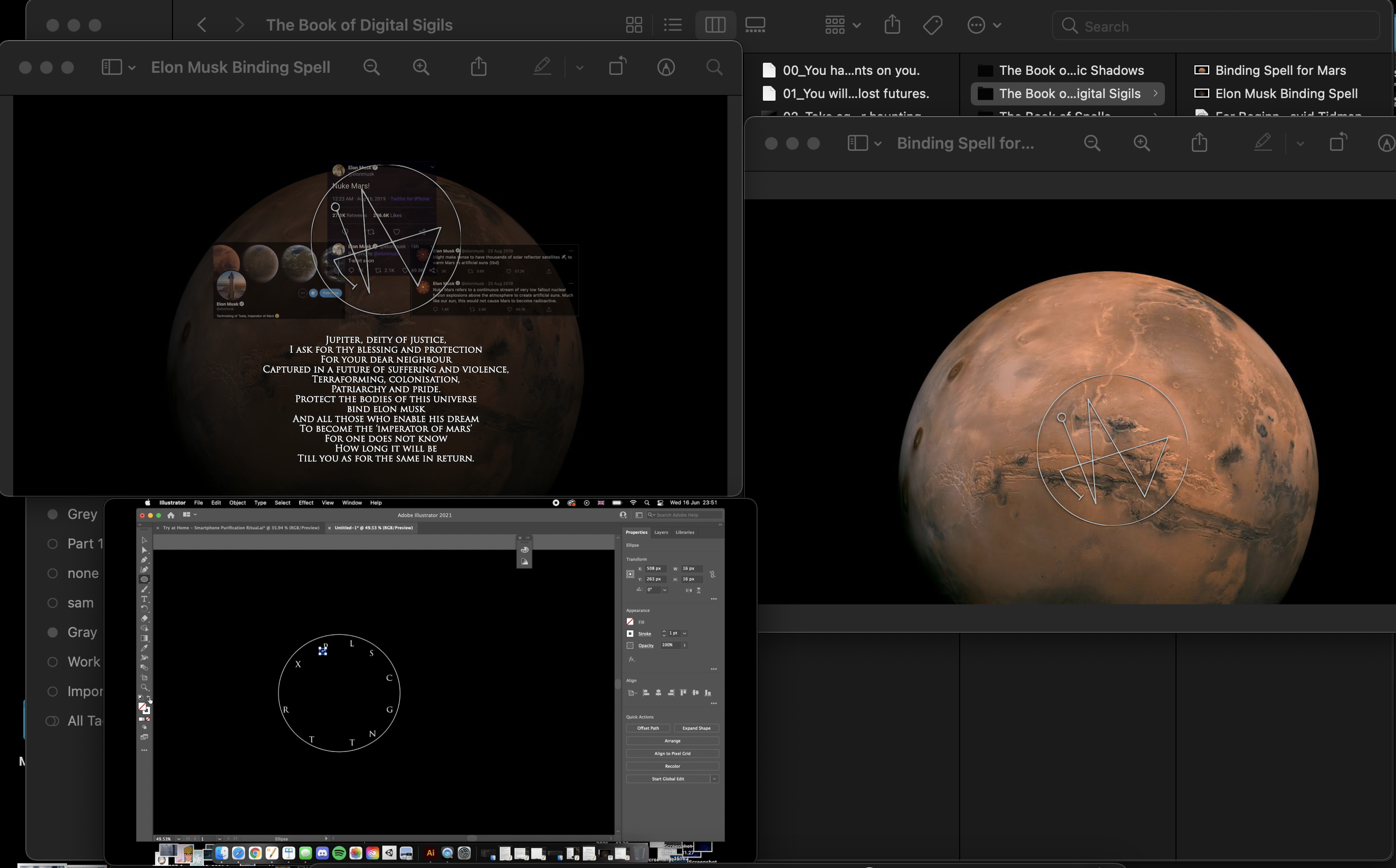
‘The Book of Digital Sigils’ was created as a response to the capitalist and techno-colonialist forms of production and acts as an active resistance towards the capitalist hegemony over futures and the figures that reproduce values of colonisation and exploitation. The practice of binding spells and digital sigil making follows Judy Wajcman’s call for action that “we shouldn’t leave technological design to silicon valley, we shouldn’t leave a bunch of engineers in charge of defining the future, and telling us what’s valuable in life and how we should live” (LSE, 2015, 05:30). As an attempt to alter reality though the graphic ‘cut’ (Kember, Zylinska, 2012), these works bring attention to states eco-anxiety and fear that certain members of societies might be affected by when reflecting on plausible futures. As a means of combatting the feeling of helplessness, ‘The Book of Digital Sigils’ focuses on practice that instead makes the audience manifest the hopes and desires for preferable futures to come. Inspired by traditional forms of sigil making, these spells bind intent and desire to a digital materiality and once shared through social media, spark a community-led form or resistance similar to #bindtrump.
The Study: The Book of Spells

Working
‘Sonic Emoji Spell for Grandma’ was created for that purpose, to not only explore how memories can be attached emojis, but also bring to situations where the use of those can no longer continue. As a deeply personal audio letter to her grandmother, the witch expresses emotions of loss, love and nostalgia through auditory description of emojis. The witch highlights how the visual language of emojis can express desires, contain unspoken insinuations or meanings, and manifest emotions. In this scenario the use of emojis as an expressive, emotive and sensuous medium, allows the witch to feel through digital media and communicate with her grandmother that can no longer use emojis due to a visual impairment.
By exploring Emoji spells we can mediate on these new ways of healing, rehabilitation and resurgence in the midst of new and existing personal crises. In future sections, I would also like to include a book of Spells for Future Intents which would use photoshop as the facilitator of the ‘cut’ (Kember, Zylinska, 2012) and ‘remix’ (Russell, 2020) to create alternative realities by modifying news headlines or social media statuses to challenge the idea of ‘truth’.
Portal back to Ayerel

The time-frame of the journey through the archive of Into the Ethereal is dependent on the participant; during audience testing there were participants that took over an hour and ones that took 15 minutes. I believe it became apparent that it is easy to lose yourself and get lost in the amount of content, however each interaction had to have a definite beginning and an end. The intention behind this folder interactive fiction, was to allow the audience to have control over how long they spend investigating and studying this cyber feminist archive. The end of the experience would occur when the participant finds the ‘Portal back to Ayerel’ and encounters the goodbye message and last words. The dialogue between the witch and the audience comes to an end with a text message that outlines the motives and intentions behind this memoir. By stating that “digital technology is something that is not cold, hard, lifeless or unnatural, rather a sensuous, emotive and spiritual extension of ourselves” the narrative intends to convince the audience that digital technology is an assemblage that is mouldable and can be transformed through thought and pure will. This ending message intendes to conclude the experience and remind the audience of the cyber feminist nature of witchcraft, its ability to de-naturalise socio-technical constructs and provide a new way of seeing, knowing and practicing.
Summary
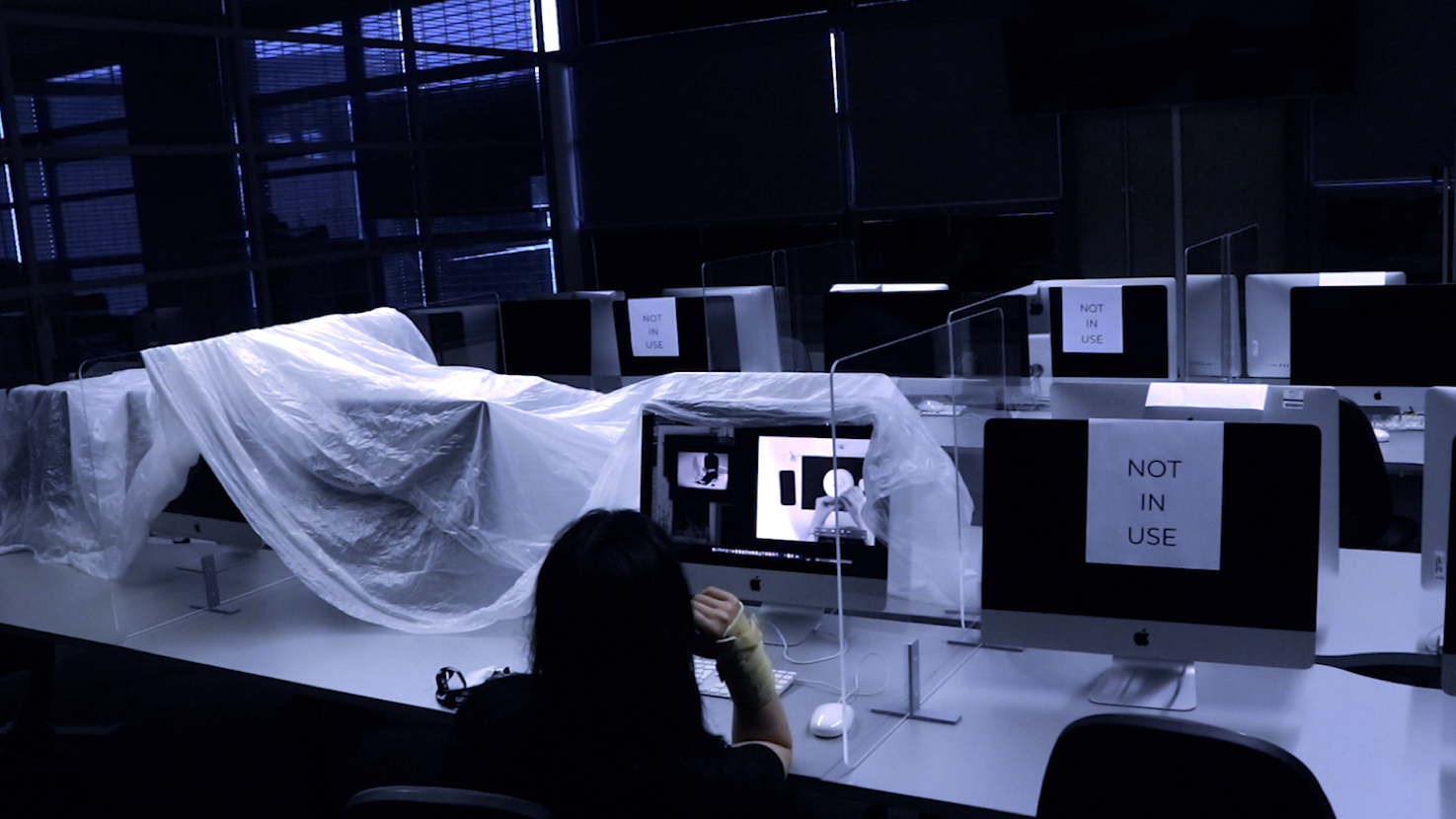
What was the purpose and value behind the practice in Into the Ethereal?
What is the justification behind the choice of externalising it into an interactive archive?
What was the motive behind the choice of creating this digital experience, was it purely an attempt to achieve digital immortality?
Since the experience was created for the purpose to be found and explored, it is important to view the witch as not only a provocateur and creative but also a facilitator of practice that re-imagines the present as preferable realities. Through the democratisation of witchcraft, the witch attempts to show how spiritual manipulation of digital media can turn to a form of activism that questions and challenges the restrictive visions of the future. In parallel with Glitch Feminism, digital witchcraft dissolves the boundary between ‘internet art’ and performance, activism and community-building (Russell, 2020). Into the Ethereal offers a toolkit for new-comers who want to manifest values of new materialism, internet equality and post-humanism. It motivates the participants to spark debates over the effects patriarchal capitalism has on the upcoming futures.
The project responds to the current proliferation of witchcraft in social media spaces which suggests a desire for new ways of creating connection, existential meaning and self care. Inspired by contemporary practices of Tumblr witchcraft, Into the Ethereal plays with the languages and semiology of information and communication technologies; such as file systems, data storage or social networks. For these speculative witches digital witchcraft becomes a creative material and outlet for inclinations, which allows for the release of social discomfort and frustration towards capitalist hegemony.
The spatiality of Photoshop, code and social media allow for new worlds to be created and current realities modified, where witchcraft becomes a participatory, political action that challenges the status quo and empowers the creation of glitches that refuse, mobilise and encrypt (Russell, 2020). The different sets of semiotics, languages and constructs inherent in witchcraft provide the designer with a way to estrange familiarity and disassemble the conventions and interfaces of digital technologies, making it possible to regard everyday objects and practices through a new perspective. The practice of digital witchcraft in Into the Ethereal lies beyond standard perception, cognition and experience of digital technology, but rather in the creation of intimate relationships and views on the affordances these technologies provide.
The project is a personal catalyst to using cyberwitchcraft as a methodology to materialise new futures where relationships with technological systems are re-imagined, critiqued and defamiliarised through spiritual practice. This project uses experimental realism as a ficto-critical method of storytelling and speculation, where it provokes more questions than it suggests answers. However, its value perhaps does not lie in the speculation of future rituals and attitudes towards technological fossils, but rather in its ability to unveil the questions around digital spiritual practice that are currently unheard and situate them in public discourse.
We might be tempted to ask why should we care or discuss the mortality or immortality of internet decay and most importantly why would we ever return to it? The use of speculative rituals around abandoned technology could allow an audience to think through the present and its implications, on issues that might magnify in the future; such as values of separate togetherness, digital immortality and digital existence that might become stronger with the future to come. This project aims to spark debate on how speculative rituals provoke discussion on the nature, use and consequences of information technology and new media. By using "broken world thinking" (Jackson, 2014, p.221) and world building techniques, Into the Ethereal explores how social worlds could react and make claims on the nature of technological fossils, if enough attention and value was attributed to them through a nostalgic lens of appreciation of the limits and temporality of the worlds we inhabit. The question then becomes what we make of these facts, and what do we do next?
Behind the Scenes
Inspiration from Tumblr Witchcraft

My practice was motivated by the exploration of how contemporary witchcraft meets the challenges of the 21st century. As Lucille Haute claims: “personal collapses (burn out) and collective collapses (climate change, endangered biodiversity) are heralds of societal and environmental challenges which humanity will have to face in the coming years” (Haute, 2020, p.86). This proliferation of the witch in social media signals an emerging desire for new ways of creating connection, existential meaning and self care amidst personal and collective crises. Additionally, the contemporary witch offers a platform for disobedience and even critique of the existing world order. On Reddit we can find r/WitchesVsPatriarchy, on Instagram we can access tips from the #witchesofinstagram, Tumblr has a multitude of classifications of witchcraft such as #digitalwitchcraft or #techno witchcraft and Twitter witchcraft has recently gained attention due to the community-led protest called #bindtrump. As a result of this resurgence, it is possible for anyone with an internet connection to gain access to the basics of paganism and witchcraft. Through primary research I investigated this social-media spirituality and the ventures to spellbinding parts of the internet in an attempt to find an outlet for self-empowerment and healing energies. There is an influx of news material that tries to understand the influx of influencer witches, and women practicing, re-introducing and re-thinking the ancient craft. However, there is little exploration on ways witches might use non-conforming approaches to digital technologies. Into the Ethereal is a response to this new wave of interest in creating ritual spaces and practices and explores this knowledge gap through a speculative critical design practice.
Broken world thinking
Broken world thinking supported my practice in creating a narrative that uses “decay, rather than novelty, growth, and progress, as our starting points in thinking through the nature, use, and effects of information technology and new media” (Jackson, 2014, p.221). I wanted to create an experience that evokes feelings about the future rather than creating a succinct definite vision of the future. Therefore I decided to focus on using fictive practices as a prototyping method, where “the logic of a story world is used as a thinking tool for exploring embodied interaction within situated narrative contexts” (McVeigh-Schultz, 2016, p.viii). Using world building techniques such as the future wheel, I began to tinker with the mechanics of existing interactions to form rituals that do not exist yet, but with a change of views and environmental circumstances could become plausible futures. Additionally I returned back to the method of the ‘cut’ (Kember, Zylinska, 2012) for critique and the ‘remix’ (Russell, 2020, p.104) as a methodology of finding new ways of innovating with the existing and creating new forms of interaction based on already visible trends in behaviour.
Worldbuilding
By thinking through writing, the scenario making process was an iterative endeavour to imagine the rise of witchcraft in a world where cyberwitches are increasingly more influenced by digital affordances to create practice that comments against techno-capitalism and the consumptive use of technology. I wanted to explore a new form of appreciation for digital technology and the ruins it leaves behind and frame witchcraft as a methodology to imagine new futures, where new relationships with objects are created by reworking through existing technology. For these witches technology would not be seen as cold, hard, or artificial, but rather as an energy and assemblage that can be worked with. As previously mentioned in my critical reports, the contemporary witch has become a figure that gives legitimacy to do new things, to share knowledge and create means of connection.The skilled knowledge of the contemporary witches is in how they are narratively skilled, enacting new things and bringing the new through fictive ritualistic practice.
Currently there is a hegemony over how the future is portrayed, and that would be exponential growth, progress and innovation. However, by looking back and developing narratives from decay instead of novelty, I wanted to introduce digital witchcraft as a means of creating value and connection with existing objects. Since I was placing my experience in a speculative Post-Internet future, I had to imagine how a collapse of a network system would precipitate the witchcraft community to create an active response; where witches would repurpose technological ruins and assign them new roles, meanings and purpose. An abandoned desktop computer would then allow the audience to enter this creolised network via a technological rites of passage. Upon activating the computer, what interaction might you encounter? Are they purely of the past or are they also taking place now? Could this be a data base or a receiver where signals are sent from elsewhere and you are haunted by memories of anonymous third parties? What kind of memories and why would they be sent?
Using the Film as a Framework

The Into the Ethereal film already worked as an object in itself, however rather than proposing a clear experience it appeared as a trailer, snippet or an excerpt of an alternative reality continuing elsewhere. alternative reality continuing elsewhere. The ambiguity of the performance at the table during Chapter II, makes the gestures appear as part of something larger, more meaningful, that could continue elsewhere and satisfy the curiosity and questions of the audience. Therefore I started to think through ways to extrapolate these three chapters and expand on them through further film media and physical artefacts. By creating these Miro boards I intended to ask myself how to does chapters relate between themselves and how do they represent a larger world? It was important to identify this relationship and think of ways to create a continuity that connects these chapters throughout the experience. I was thinking of how to create exhibition or a ritual that alludes to the performance in the video (which already feels as a ritual) and how the chapters could provide to be an interesting constraint to what I will build, how it will extend and how will I use space.
Why ritual?
The work of McVeigh-Schultz exceptionally inspired my thinking through fictive practice and ritual making. These two quotes remained in my mind throughout the entire practice based process:
“The work that ‘ritual’ as a concept does within a design context—in contrast to a term like ‘practice’—is connected to its ability to defamiliarize. The term ritual—especially when applied to more mundane practices that rarely get this designation tends to place us in the perspective of an alien anthropologist visiting earth.The key here is that ritual is an etic term, an analytical category likely to be deployed by an outsider to describe the culture of an Other.” (McVeigh-Schultz, 2016, p.18)
“Like designers, ritual theorists tend to approach their object of study with a high degree of granularity and attention to detail. This detail includes an attention to the details of embodiment and form. They attend to the body’s relationship to the boundaries of space and time and to the roles of props and other objects.”(McVeigh-Schultz, 2016, p.19)

Narrative Development
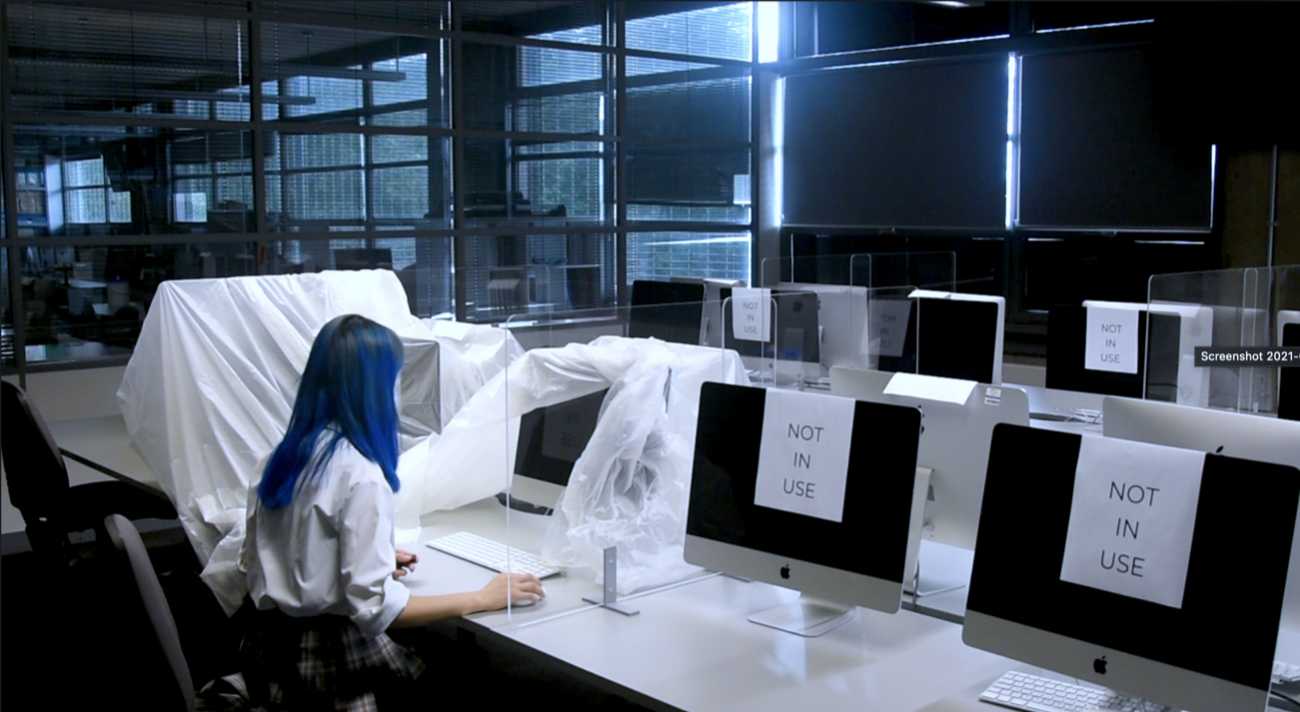
As the narrative of Into the Ethereal was placed in a specific vision of the future it was important to develop ways in which the storyline could have been communicated to the audience with a threshold designed to allow the participants to step into a drastically different reality. Therefore, I experimented and investigated how the physical environment of the interaction and an opening film scene could place the audience into the scenario and set the scene of discovery of the rite of passage. The opening scene was intended to place the narrative in the context of the Post-internet future and it portrayed the place where Into the Ethereal could be found. Through this storyline, the experience is touching upon the theme of separate togetherness, which is continuously explored in my work. Here, separate togetherness lies between the past and the future, the present mind and absent body of the witch and the feeling of connection through digital material despite temporal and corporeal separation. By making the audience experience an alternative reality, that has passed and gone, I intended to show how digital fossils can allow us to look into ourselves, into lost futures and into the relics our externalisation will once become. Inspired by Fisher’s theory of the Weird and Eerie (2016), at first the experience intends to be eerie as the audience is not certain of who made Into the Ethereal and what set of beliefs made it meaningful at the time. An eerie feeling similar to when we are confronted with Easter Island or Stonehenge. However, as the audience progresses, the experience intends to turn rather weird, as the practice of this cyberwitch ‘does not belong’ (Fisher, 2019, p.7) to the current techno-capitalist and consumerist reality and is practiced despite the feeling that it should not exist.
Iconography

I see parallels between the abandoned physical landscape and the derelict digital space, where through a rite of passage we find ourselves amongst memory, externalisation and networks “we are not sure of, who made them or the set of beliefs that made them meaningful at the time” (Fisher, 2016, p.7). I wanted to emphasise this parallel by imagining the finder folders as an architectural space; a witch hut to be exact. Therefore I decided to create iconography that could replace the icons of the folders and tie the content of the folders to a physical space.